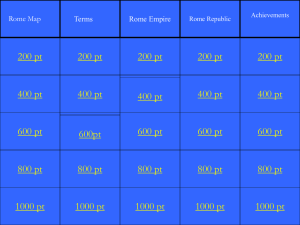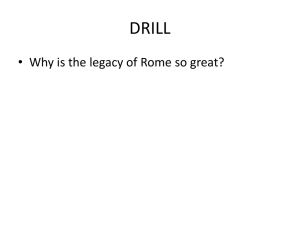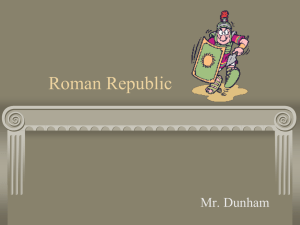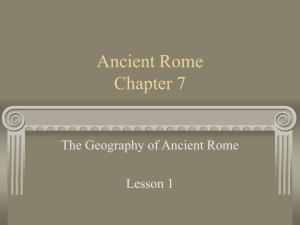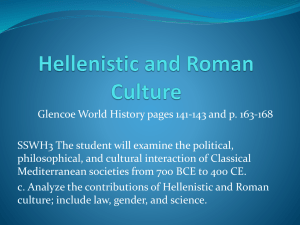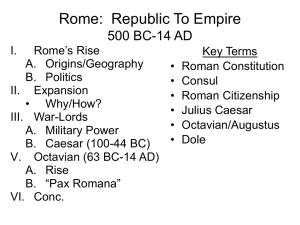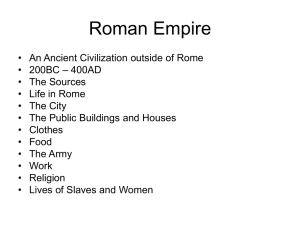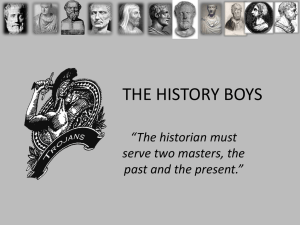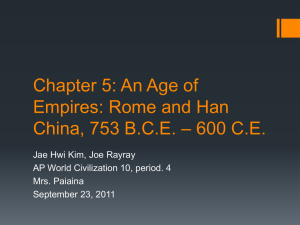Chapter 14
advertisement
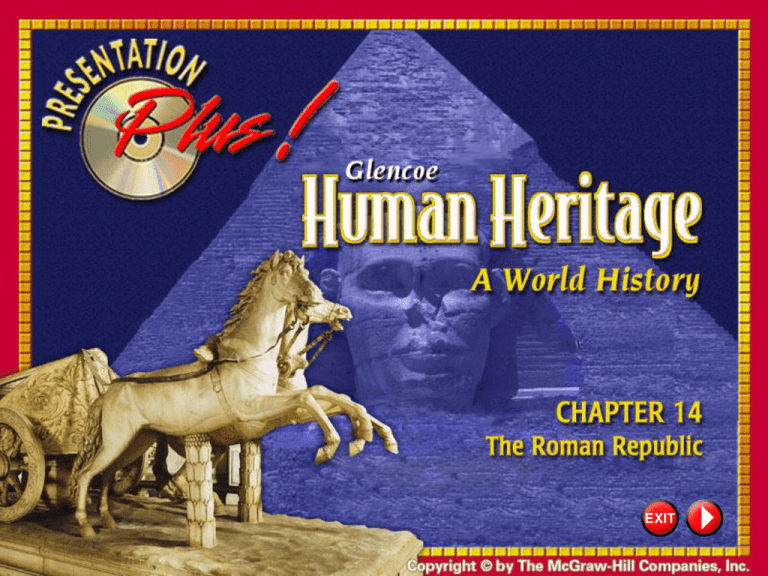
CHAPTER FOCUS SECTION 1 The Government SECTION 2 Roman Expansion SECTION 3 The Punic Wars SECTION 4 Effects of Conquest SECTION 5 Roman Leadership CHAPTER SUMMARY & STUDY GUIDE CHAPTER ASSESSMENT 2 Click a hyperlink to go to the corresponding section. Press the ESC key at any time to exit the presentation. Overview • Chapter 14 traces Rome’s development as a republic. – Section 1 summarizes the rise of Roman democracy. – Section 2 describes the army’s role in the Roman Republic. – Section 3 discusses Rome’s rise to power in the Mediterranean region. – Section 4 analyzes the effects of foreign conquests. – Section 5 examines the attempts to solve the Republic’s problems. 3 Click the mouse button or press the Space Bar to display the information. Objectives After studying this chapter, you will be able to: • describe how the Roman government was organized. • explain how the Roman Republic was able to expand. • summarize how the effects of conquest changed the Roman economy and government. • discuss efforts to save the Roman Republic. 4 Click the mouse button or press the Space Bar to display the information. Read to Discover • How the government of the Roman Republic was organized • How the Roman Republic was able to expand and protect its territory • How the effects of conquest changed the Roman economy and government • How reformers attempted to save the Roman Republic 5 Click the mouse button or press the Space Bar to display the information. The Chapter Focus is on page 219 of your textbook. Terms to Learn • republic • patricians • plebeians • consuls • legionaries • dictator • triumvirate People to Know • Tarquin the Proud 6 People to Know (cont.) • Hannibal Barca • Tiberius Gracchus • Julius Caesar • Mark Antony • Octavian Places to Locate • Carthage • Sicily • Gaul • Corinth Click the mouse button or press the Space Bar to display the information. Click the Speaker On button to listen to the words. Why It’s Important In 509 B.C., the Romans overthrew Tarquin the Proud, their Etruscan king, and set up a republic. Under this form of government, people choose their rulers. However, not everyone had an equal say in the Roman Republic. The patricians–members of the oldest and richest families–were the only ones who could hold public office or perform certain religious rituals. Poorer citizens, known as plebeians, paid taxes and served in the army. Yet they could not marry patricians or hold office. If they fell into debt, they could be sold into slavery. In later years, reformers would take steps to make the Roman Republic more democratic. The idea of a government chosen by the people would serve as a model for future generations, including the founders of the United States. 7 Click the Speaker On button to replay the audio. The Government • At the head of the Roman Republic were two consuls, administrators and military leaders, who were chosen each year. • As each had the power to veto, or say no to, the acts of the other, both had to agree before any law was passed. • Next in importance was the Senate. • Three hundred senators were chosen for life to handle daily problems and advise consuls. 9 Click the mouse button or press the Space Bar to display the information. Section 1 begins on page 219 of your textbook. The Government (cont.) • Judges, assemblies, and tribunes, or government officials who protected the rights of plebeians, were also part of the Roman government. • In 450 B.C., Roman laws were carved on 12 bronze tablets known as the Twelve Tables and placed in the Forum. • The election of tribunes and recording of laws were the first steps to a more democratic government. 10 Click the mouse button or press the Space Bar to display the information. Section Assessment What were some restrictions placed on the plebeians during the early years of the Roman Republic? They could not marry patricians or serve in the government, and if they got into debt, they could be enslaved. 11 Click the mouse button or press the Space Bar to display the answer. Section Assessment (cont.) Demonstrating Reasoned Judgment Why do you think it was important for the Romans to have laws written down? Answers will vary, but it could be noted that recording laws makes them enforceable. 12 Click the mouse button or press the Space Bar to display the answer. Section Assessment (cont.) Draw the diagram on page 220 of your textbook, and use it to describe each part of Roman government. Descriptions should match each of the parts of government discussed in Section 1. 13 Click the mouse button or press the Space Bar to display the answer. Roman Expansion • The Romans worked to protect their republic because they were afraid that the Etruscans would try to get back control of Rome. • To protect their new boundaries, the Romans either conquered their neighbors or made alliances with them. • By 146 B.C., Rome ruled most of the Mediterranean world. • The Romans gained territory because their strong army was organized into legions. 15 Click the mouse button or press the Space Bar to display the information. Section 2 begins on page 221 of your textbook. Roman Expansion (cont.) • Each legion contained some 5,000 soldiers called legionaries and was divided into groups of 60 to 120 soldiers. • The Romans were mild rulers, and as a result many enemies of Rome became loyal Roman allies. 16 Click the mouse button or press the Space Bar to display the information. Section Assessment Why were the Romans able to gain territory? They gained territory because they had a strong army that was organized into legions. 17 Click the mouse button or press the Space Bar to display the answer. Section Assessment (cont.) What was life life for a Roman legionary? They spent hours training each day and had had to construct fortifications and roads. 18 Click the mouse button or press the Space Bar to display the answer. Section Assessment (cont.) Drawing Conclusions How would you describe the way the Romans treated people they conquered, and do you think this was wise? Explain. Answers will vary but it could be noted that by treating people mildly Romans gained their loyalty. 19 Click the mouse button or press the Space Bar to display the answer. Section Assessment (cont.) Draw a chart like the one on page 222 of your textbook, and use it to show the cause and effects of Roman conquest of Etruscan cities. causes–wanted to protect the republic, feared Etruscans might try to retake Rome effects–Roman land now bordered other Italian peoples, conquered or made alliances with their neighbors, eventually secured control of the whole peninsula 20 Click the mouse button or press the Space Bar to display the answer. The Punic Wars • By 264 B.C., the Romans had conquered some Greek city-states in southern Italy, bringing them into contact with the Phoenician city of Carthage. • The Romans felt threatened by the Carthaginians, and they also wanted Sicily’s granaries. 22 Click the mouse button or press the Space Bar to display the information. Section 3 begins on page 222 of your textbook. The First Punic War • In 264 B.C., the Romans and Carthaginians clashed in a war that lasted for 23 years. • It was the first of three wars between Rome and Carthage that came to be known as the Punic Wars. • Carthage’s military strength lay in its navy, while Rome’s lay in its army which defeated the Carthaginians. • In 241 B.C., the Carthaginians agreed to make peace and left Sicily. 23 Click the mouse button or press the Space Bar to display the information. Hannibal and the Second Punic War • In 218 B.C., the Second Punic War began. • The Carthaginians, led by General Hannibal Barca, attacked the Roman army by land from the north. • He was unable to capture Rome. • Then, the Romans attacked Carthage, and Hannibal was called home to defend it and he lost his first battle. • In 201 B.C., Carthage agreed to pay Rome a huge sum of money and to give up all its territories, including Spain. 24 Click the mouse button or press the Space Bar to display the information. The Third Punic War • To prevent Carthage from gaining power, the Romans attacked in 149 B.C., the Third Punic War. • In 146 B.C. the Greek city-state of Corinth and some of its allies refused to obey a Roman order. • The Romans attacked Corinth and burned it to the ground. • Rome became the leading power of the Mediterranean world. 25 Click the mouse button or press the Space Bar to display the information. Section Assessment What territory did Carthage control in 264 B.C.? Carthage controlled all of North Africa, most of Spain, some islands off the coast of Italy, and the western half of Sicily. 26 Click the mouse button or press the Space Bar to display the answer. Section Assessment (cont.) What happened to Carthage in the Third Punic War? The city was burned, its land was destroyed by plowing salt into the fields, and its people were killed or sold into enslavement. 27 Click the mouse button or press the Space Bar to display the answer. Section Assessment (cont.) How did Rome become the leading power of the Mediterranean world? Rome became the leading power by destroying Corinth and adding Greece to the areas under its rule. 28 Click the mouse button or press the Space Bar to display the answer. Section Assessment (cont.) Predicting Consequences What might have happened to Rome if it had lost the Punic Wars? Answers will vary but might indicate that Rome would not have been able to expand its republic or might have been taken over by the Carthaginians. 29 Click the mouse button or press the Space Bar to display the answer. Section Assessment (cont.) Draw a chart like the one on page 224 of your textbook, and use it to summarize the outcome of each of the Punic Wars. First–Rome lost many ships and soldiers, but defeated the Carthaginians and forced them to leave Sicily. Second–Carthage agreed to pay Rome a huge sum of money and give up all its territories, including Spain. Third–Rome added Greece to its empire and became the leading power in the Mediterranean world. 30 Click the mouse button or press the Space Bar to display the answer. Effects of Conquest • The conquests and the wealth changed Rome’s economy and government. • Among the changes were… – the replacement of small farms by large estates. – the coming of slavery. – a movement from farms to cities. – the decline of the Roman Republic. 32 Click the mouse button or press the Space Bar to display the information. Section 4 begins on page 224 of your textbook. Agricultural Changes • Rome’s conquests brought changes in agriculture. • Large estates called latifundias replaced the small farms. • Hannibal’s invasion was the main reason for this change. Roman farmers had burned their fields and crops to prevent Hannibal’s soldiers from living off the land. 33 Click the mouse button or press the Space Bar to display the information. Agricultural Changes (cont.) • By the end of the Second Punic War, much of the land was ruined, and small farmers could not afford to restore the land. • Patricians and rich business people bought small farms and combined them to make latifundias. • Another change in agriculture was in who worked the land. • The Romans sent thousands of prisoners to Rome as enslaved people to live and work on latifundias. 34 Click the mouse button or press the Space Bar to display the information. From Farm to City • The farmers who had sold their land could stay and work for the new owner or move to the city. • Almost all moved to Rome into crowded apartments with terrible living conditions. • Most farmers could not get jobs and got money by selling their votes to politicians. 35 Click the mouse button or press the Space Bar to display the information. Decline of the Roman Empire • As Rome’s rule spread beyond Italy, the Romans began to demand taxes and enslaved people. • Tax contracts were sold to people called publicans who collected taxes from the conquered people. • By about 135 B.C., Rome was in a great deal of trouble. • The gap between rich and poor and political unrest grew greater and Rome was no longer politically stable. 36 Click the mouse button or press the Space Bar to display the information. Section Assessment How was Roman agriculture influenced by Hannibal? Roman farmers burned their fields and crops. After the Second Punic War, most farmers did not have money to restore the land, so latifundias appeared, which produced cash crops. Farmers were replaced by enslaved peoples. 37 Click the mouse button or press the Space Bar to display the answer. Section Assessment (cont.) What was it like in Rome during the decline of the republic? Life was hard for most farmers, merchants, and artisans. Government officials became rich and the gap between rich and poor grew greater. 38 Click the mouse button or press the Space Bar to display the answer. Section Assessment (cont.) Identifying Central Issues Why might a large gap between rich and poor present problems for an empire? Answers will vary but you might indicate risk of rebellion. 39 Click the mouse button or press the Space Bar to display the answer. Section Assessment (cont.) Draw the diagram on page 226 of your textbook, and use it to compare Roman agriculture before and after the rise of latifundias. Roman agriculture shifted from hard working farmers loyal to Rome to large estates where enslaved people produced cash crops for sale. This led to a large gap between the rich and poor and ultimately the decline of the Roman Republic. 40 Click the mouse button or press the Space Bar to display the answer. Roman Leadership • Over the next 100 years, many different popular leaders–reformers and generals– tried to improve conditions in Rome. 42 Section 5 begins on page 227 of your textbook. The Reformers • Tiberius Gracchus became a tribune in 133 B.C. and was the first reformer. • He wanted to limit the amount of land a person could own. • He was killed in a riot staged by the Senate when he ran for a second term as tribune. • In 123 B.C., Tiberius Gracchus’s younger brother, Gaius Gracchus, was elected tribune. • When the Senate began to feel threatened by his ideas in 121 B.C. they had him killed. 43 Click the mouse button or press the Space Bar to display the information. The Generals • In 107 B.C., General Gaius Marius, a military hero, became consul. • Marius thought he could end Rome’s troubles by setting up a professional army, open to everyone. • Another general, Lucius Cornelius Sulla, was given a military command that Marius wanted. • Marius tried to get the assembly to take the command away from Sulla. 44 Click the mouse button or press the Space Bar to display the information. The Generals (cont.) • An angry Sulla marched his army and seized Rome and civil war broke out. • When it was over, Sulla made himself dictator, or absolute ruler, of Rome. 45 Click the mouse button or press the Space Bar to display the information. Julius Caesar • When Sulla retired, a new group of generals fought for control of Rome. • In 60 B.C., political power passed to a triumvirate, or a group of three persons with equal power. • Julius Caesar finally gained control, after a power struggle, in 48 B.C. • In 58 B.C., Caesar was named governor of a Roman province and built up a large, strong loyal army. 46 Click the mouse button or press the Space Bar to display the information. Julius Caesar (cont.) • The Senate ordered him in 50 B.C. to break up his legions and return to Rome. • Instead, Caesar entered the city at the head of his troops, and by 46 B.C., he was dictator of Rome. • Caesar brought about many reforms of land and wealth distribution. • Some Romans were afraid that Caesar planned to make himself king. • As he entered the Senate on March 15, 44 B.C., Caesar was stabbed to death. 47 Click the mouse button or press the Space Bar to display the information. End of the Republic • Political power passed to another triumvirate. – Marcus Antonius, or Mark Antony, Caesar’s closest follower and a popular general, took command of Rome’s territories in the East. – Octavian, Caesar’s grand-nephew and adopted son, took charge of the West. – Marcus Aemilius Lepidus, one of Caesar’s top officers, took over the rule of Africa. • For a while, the triumvirate worked. Then fights broke out, leaving Octavian as sole ruler of the Roman Empire in 31 B.C. 48 Click the mouse button or press the Space Bar to display the information. Section Assessment Why did civil war break out in Rome? The rise of a professional army more loyal to its commanders than Rome and conflicts between Marius and Sulla led to civil war. 49 Click the mouse button or press the Space Bar to display the answer. Section Assessment (cont.) Why did a group of Roman Senators murder Julius Caesar? They murdered Caesar because they feared he planned to make himself king. 50 Click the mouse button or press the Space Bar to display the answer. Section Assessment (cont.) Demonstrating Reasoned Judgment How effective do you think a triumvirate is as a form of government? Explain. Some might see a triumvirate as a way to check executive power. Other might see it as divisive and an invitation to conspiracy. 51 Click the mouse button or press the Space Bar to display the answer. Section Assessment (cont.) Draw the chart on page 230 of your textbook, and use it to summarize the reforms supported by popular leaders during the closing years of the Roman Republic. 52 Chapter Summary & Study Guide • In 509 B.C., the Romans overthrew the Etruscans and set up a republic. • About 450 B.C., leaders wrote down Roman laws in the Twelve Tables. • By 275 B.C., well-trained Roman legions had taken control of Italy. • Between 264 and 146 B.C., Rome and Carthage fought three wars known as the Punic Wars. 54 Click the mouse button or press the Space Bar to display the information. Chapter Summary & Study Guide (cont.) • The organization of Roman lands into large estates forced many small farmers off the land and into the cities. • By 135 B.C., Rome faced many serious political and economic problems. • A series of reform-minded leaders tried various ways to improve conditions in Rome, but political rivalries prevented any leader from holding power for long. 55 Click the mouse button or press the Space Bar to display the information. Chapter Summary & Study Guide (cont.) • After Julius Caesar was killed by Romans who feared he might become king, power was divided among three leaders. • Fights among the three-way rule of Mark Antony, Octavian, and Marcus Lepidus led to the collapse of the Roman Republic. • In 31 B.C., Octavian became the sole ruler of the Roman Empire. 56 Click the mouse button or press the Space Bar to display the information. Understanding the Main Idea What changes were made in Rome’s government as a result of demands by the plebeians? No one could be enslaved because of debt, and plebeians could marry patricians and hold public office. 58 Click the mouse button or press the Space Bar to display the answer. Understanding the Main Idea Why was the Roman legion so effective in battle? because it was small and fast and could split off and attack from all sides 59 Click the mouse button or press the Space Bar to display the answer. Understanding the Main Idea Why did Rome decide to fight three wars against Carthage? Rome fought the wars because it felt threatened by Carthage and wanted the Carthaginian granaries in Sicily. 60 Click the mouse button or press the Space Bar to display the answer. Understanding the Main Idea How were the Romans able to overcome the navy of Carthage? They added a corvus to the front of their ships, thus changing a sea war into a land war. 61 Click the mouse button or press the Space Bar to display the answer. Understanding the Main Idea What effect did latifundias have on Rome’s small farmers? They forced many farmers to move to the city. 62 Click the mouse button or press the Space Bar to display the answer. Understanding the Main Idea Who won the struggle for political power after the death of Julius Caesar? Octavian 63 Click the mouse button or press the Space Bar to display the answer. Understanding the Main Idea What effect did Marius’s reforms have on the loyalty of the legionaries? Marius’s reforms shifted the loyalty of legionaries from the government to the general who hired them. 64 Click the mouse button or press the Space Bar to display the answer. Understanding the Main Idea Why did the Senate order Julius Caesar to break up his legions? The Senate ordered this because they feared he was growing too strong. 65 Click the mouse button or press the Space Bar to display the answer. Critical Thinking How wise do you think the Romans were to enslave the people they conquered? Explain. Answers will vary, but one could note that enslaving conquered people caused dissent. 66 Click the mouse button or press the Space Bar to display the answer. Critical Thinking Do you think the Romans were wise or foolish to start taxing the people they conquered? Explain. Answers will vary, but taxing coincided with the Republic’s decline. 67 Click the mouse button or press the Space Bar to display the answer. Critical Thinking If you had lived in Rome after 135 B.C., what would you have done to solve its problems? 68 Critical Thinking If you had lived when Caesar was killed, how would you have felt about his murder? Explain. 69 Geography in History Movement Refer to the map on page 228 of your textbook. Imagine you are a government representative who must travel from Rome to Cyprus. Describe how you would travel and what route you would take. Then draw a map showing your route. Answers will vary and may include a sea route by ship or a land-sea route involving horses, carts, and ships. 70 Click the mouse button or press the Space Bar to display the answer. Predict what will happen: Julius Caesar was not murdered in 44 B.C. He continued as ruler of Rome, but was advised to share ruling with Mark Antony. The Senate has resigned in protest against Caesar’s laws. Caesar must do something– what? 71 Explore online information about the topics introduced in this chapter. Click on the Connect button to launch your browser and go to the Human Heritage: A World History Web site. At this site, you will find interactive activities, current events information, and Web sites correlated with the chapters and units in the textbook. When you finish exploring, exit the browser program to return to this presentation. If you experience difficulty connecting to the Web site, manually launch your Web browser and go to http://www.humanheritage.glencoe.com 73 31 B.C. 74 509 B.C. 264 B.C. Romans set up republic Punic Wars begin Octavian becomes sole ruler of Roman Empire 450 B.C. 46 B.C. Twelve Tables are written Julius Caesar appointed dictator of Rome Click the mouse button or press the Space Bar to display the information. Julius Caesar 102 B.C.–44 B.C. Roman General/Statesman Born into one of the oldest patrician families in Rome, Gaius Julius Caesar knew politics could be a dangerous job. Even so, he had a big advantage–the loyalty of the legions who served him. The legions helped Caesar become the reform-minded ruler of Rome, but they could not save him from murder by the senators who felt his popularity and power threatened the republic. 75 Carthage Hannibal’s Strength 76 Click a hyperlink to go to the corresponding section. Press the ESC key at any time to exit the presentation. Carthage Marcus Portius Cato, a prominent statesman and writer, believed that Carthage posed a great threat to Rome. He reportedly ended every speech–no matter what the subject–with “Carthage must be destroyed!” 77 Hannibal’s Strength Hannibal began crossing the Alps with about 46,000 troops and 37 elephants. He emerged with 26,000 troops and almost no elephants. A Roman general proclaimed: “They are ghosts and shadows of men already half dead. All their strength has been crushed and beaten out of them by the Alpine crags.” The general was wrong. The Gauls, who were enemies of the Romans, joined Hannibal and boosted his army to almost 50,000. 78 Rank and File The basic unit of the Roman legion was the maniple–120 soldiers standing side by side in ranks of 10 and lined up one behind another in files of 12. The term rank and file, which refers to the ordinary members of an organization, comes from this military system. 79 End of Custom Shows WARNING! Do Not Remove This slide is intentionally blank and is set to auto-advance to end custom shows and return to the main presentation.

